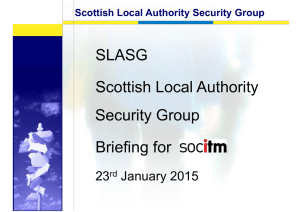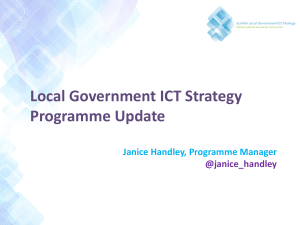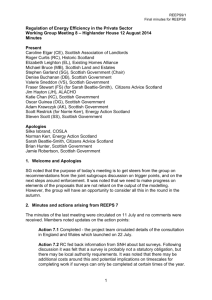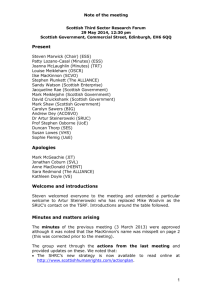Open - The Scottish Government
advertisement
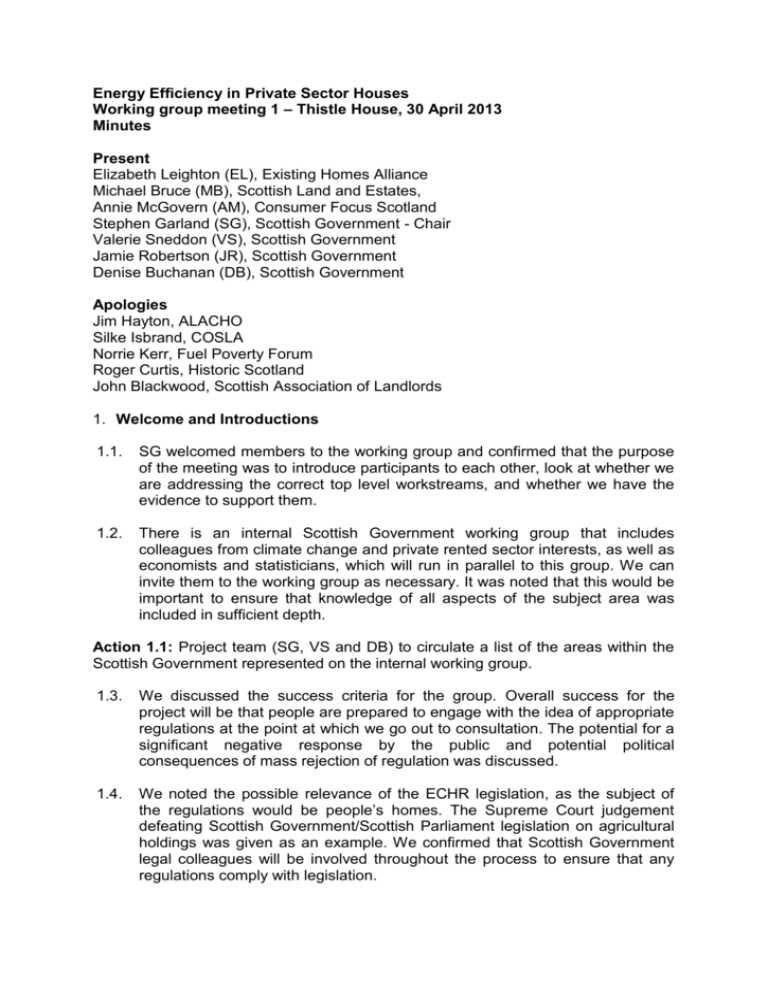
Energy Efficiency in Private Sector Houses Working group meeting 1 – Thistle House, 30 April 2013 Minutes Present Elizabeth Leighton (EL), Existing Homes Alliance Michael Bruce (MB), Scottish Land and Estates, Annie McGovern (AM), Consumer Focus Scotland Stephen Garland (SG), Scottish Government - Chair Valerie Sneddon (VS), Scottish Government Jamie Robertson (JR), Scottish Government Denise Buchanan (DB), Scottish Government Apologies Jim Hayton, ALACHO Silke Isbrand, COSLA Norrie Kerr, Fuel Poverty Forum Roger Curtis, Historic Scotland John Blackwood, Scottish Association of Landlords 1. Welcome and Introductions 1.1. SG welcomed members to the working group and confirmed that the purpose of the meeting was to introduce participants to each other, look at whether we are addressing the correct top level workstreams, and whether we have the evidence to support them. 1.2. There is an internal Scottish Government working group that includes colleagues from climate change and private rented sector interests, as well as economists and statisticians, which will run in parallel to this group. We can invite them to the working group as necessary. It was noted that this would be important to ensure that knowledge of all aspects of the subject area was included in sufficient depth. Action 1.1: Project team (SG, VS and DB) to circulate a list of the areas within the Scottish Government represented on the internal working group. 1.3. We discussed the success criteria for the group. Overall success for the project will be that people are prepared to engage with the idea of appropriate regulations at the point at which we go out to consultation. The potential for a significant negative response by the public and potential political consequences of mass rejection of regulation was discussed. 1.4. We noted the possible relevance of the ECHR legislation, as the subject of the regulations would be people’s homes. The Supreme Court judgement defeating Scottish Government/Scottish Parliament legislation on agricultural holdings was given as an example. We confirmed that Scottish Government legal colleagues will be involved throughout the process to ensure that any regulations comply with legislation. Action 1.2: MB will circulate a link to the recent ECHR case Action 1.3: Project team to provide a list of commonly used acronyms 1.5. We noted in particular the need to engage with owners throughout this process, particularly as there is no representative body for house owners in the same way as there are for other interests (such as the private rented sector or environmental interests). Whilst this is recognised through the proposed Communication workstream, which is likely to include market research into people’s motivations for, attitudes towards and capacity to deliver energy efficiency, it is something which the group may wish to discuss in more detail at a later forum. Action 1.4: The group will consider the issue of home owner representation on an on-going basis 2. Remit and Principles 2.1. The group considered paper EEPS1/1. We agreed that the remit for the group is to develop draft regulations for consultation by 2015, as agreed by the Sustainable Housing Strategy Group (SHSG) (as EEPS1/2). There was some discussion as to whether the name of the group adequately reflected this. 2.2. We agreed the membership of the core group was right (subject to action 1.4) and that we can involve other groups as necessary, by inviting them to the core group and/or to participate in sub-groups. 2.3. The group noted the arrangements for papers, and that we propose that papers and minutes will normally be available on the Scottish Government website. We agreed that the group will aim to meet every two months. 2.4. The paper proposed that the group will use the Housing Policy Advisory Group (HPAG)1 as a sounding board for reporting. We noted, however, that some members of the group had concerns over the capacity of the HPAG to take on this role at the moment, and that the future of the SHSG was to be discussed at its next meeting. Action 1.5: The group will return to the issue of reporting once the outcome of the discussions at SHSG is known. 2.5. There was some discussion around the scope set out in the paper, which we clarified only related to the scope of the regulations. We agreed that it would be useful to expand this to set out the scope of the project as a whole. In particular we will amend the scope to: 1 include work on engaging with owners and landlords, behaviour change/attitudes and information provision/ communication http://www.scotland.gov.uk/Topics/Built-Environment/Housing/reform/hpag 2.6. include consideration of additional trigger points – for example whether standards should apply at point of sale or rental, and/or other interventions such as consequential improvements; and whether a phased approach may be appropriate include consideration of different regulatory options – for example, whether these may be different by building/tenure type and location (urban/rural) expand the line on “impact assessments” to also include owners of properties as an example the need to look at implementation issues at the same time as considering the outcomes the regulations we’re aiming to achieve, so that a balanced strategic approach is considered We will also clarify that although condition and other related issues are included as being outwith scope they will still be relevant to discussions. Action 1.6: Project team will revise the scope section of EEPS1/1. 2.7. We noted that Homes that don’t cost the earth consulted on principles to underpin work to develop minimum standards. A number of responses expanded on the existing principles, and we agreed that “enforceable” should be added to these principles to take account of feedback to the consultation. 2.8. We discussed external relations and the Energy Act requirements for minimum standards for energy efficiency in the private rented sector in England and Wales by 2018. We noted that the internal working group includes colleagues who have links with the work being done by the Department for Energy and Climate Change (DECC) and the Department for Communities and Local Government (DCLG). There was also some discussion about the need for expert advice on, for example, assessment process, the accuracy of EPCs and ventilation/condensation issues. And working group members agreed to share information on what is happening in other European countries. Action 1.7: Project team will provide updates to the working group meetings on progress in England and Wales on an on-going basis. Action 1.8: Project team and group will draw in other outside expertise as necessary, for example on the detail of assessment and the role of EPCs. 2.9. The group noted that the Scottish Government will carry out a Business and Regulatory Impact Assessment (BRIA). This will be on-going throughout the process and will be published in draft as part of the consultation on regulations. 3. Current Energy Efficiency in Private Sector Housing 3.1. JR introduced paper 4 on energy efficiency in the private sector (EEPS1/4). The presentation explained some of the observed differences in energy efficiency (SAP) ratings and carbon emissions between social, owned and privately rented housing. There was some discussion about whether issues such as floor sizes also had an impact, how running and upgrade costs were calculated, and the potential implication of these on costs. 3.2. We confirmed that we will draw on other sources of information, or commission further research, as necessary (for example to be picked up as part of the work around the evidence workstream). 4. Proposed workstreams and timescales 4.1. VS introduced Paper 5 on the proposed process and timescales for taking forward this group (EEPS1/5). 4.2. There was broad support for the idea of breaking the work down into workstreams, with some discussion about what issues would be considered within each of the workstreams proposed, and recognition that a number of these are interrelated. 4.3. Some themes will be overarching, such as the work around attitudes and behaviour change, and evidence gathering. Financial sustainability and impacts on the market were also raised as particular cross cutting issues. 4.4. There was some discussion on the proposed work plan, which was set at a very high level at this stage. We noted that the current proposal is for consultation by 2015, with a lead-in time before any minimum standards are introduced. Members of the group identified the need to balance ensuring there was capacity to meet standards with a need to provide early indications of any future regulation to provide certainty for the market. 4.5. It was also noted that the RPP debate suggested support for revisiting the issue of timescales. The group noted that the current work plan proposes that the group make recommendations to Ministers on timing by the end of 2014. 4.6. The project team will provide a more detailed project plan once agreement on the workstreams has been reached (likely to be following the workshop). 5. Evidence Base 5.1. The group briefly considered Paper 6 (EEPS1/6) which set out an initial scoping of the evidence base. We confirmed that we have a budget to commission research and marketing, but not for consultancy. 5.2. Consumer Focus has research on tenements and owner occupiers, which will be included in the list. 5.3. We will look at what we can learn from the work on Energy Efficiency in the Social Sector (EESSH). 6. Next Steps and AOB 6.1. We will organise a “brainstorm” workshop for group members, and potentially other interests within the Scottish Government, to provide more information and discussion on each other’s ideas and how the workstreams will work and what issues they will cover; and to begin to look at what evidence we have and may need. Action 1.9: DB to circulate possible workshop dates (to be held by mid-June) 7. Next meeting 7.1. We will aim to have dates identified for the next two meetings on a rolling basis (to meet approximately every 2 months, as agreed). It was agreed that Thistle House was an appropriate venue, though we can consider the use of video or teleconferencing if that is more convenient. Action 1.10: DB to Circulate dates for next two main meetings






